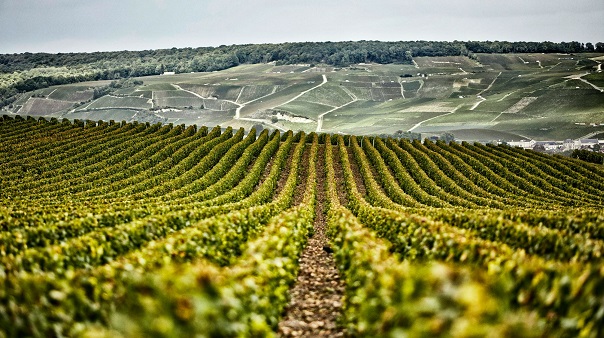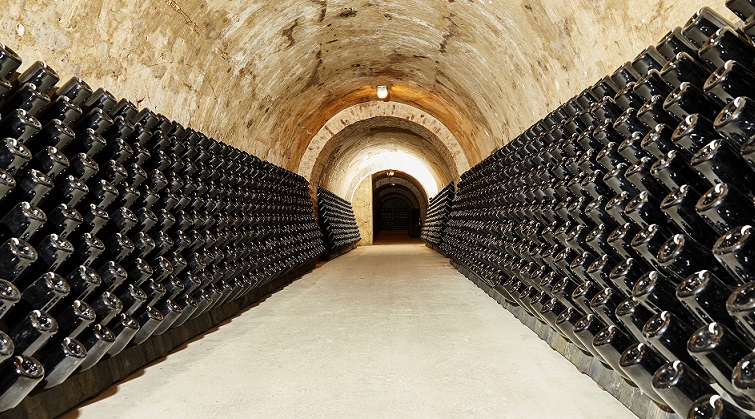It’s his way of recognising the huge part they play in the tremendous success of this family-owned grand maison.
“I have a big party with them and share the success – the prizes and gold medals,” he tells Canopy. “We share a good moment together. They love that. I have to give back the success to this guy working on the top site at the beginning of the process – when he’s pruning in -2°C.”

Laurent says he knows which growers’ grapes are in which tank. “It’s very useful for understanding the evolution of the wine – to know since the beginning how they grow the grapes. This is very important for me.”
About 95% of Henriot’s production is non-vintage Champagne. Laurent, who was born in the region but has made wine in New Zealand, South Africa, Portugal and the south of France, spends a great deal of time with his growers in their premier cru and grand cru vineyards (like those above).
“They are not a number,” Laurent stresses. “They are part of the cuvée and part of the success of Henriot.
'Without them, I’m nothing'“When we discuss together, we are all on the same level. Without them, I’m nothing. I need them; it’s collective.”
He wants everyone connected with the process to feel part of “the big family”.
“My winemaking is much more human,” Laurent reveals. “When I select the area and the growers, I select by the people working in the vineyards.
“I ask them how they work – if it’s a job or if it’s in their blood.”
Champagne is in Laurent’s DNA – his father and grandfather made Champagne and he jokes he was “born in a tank”. Before joining Henriot, he worked for Champagne producers Cazals in Le Mesnil-sur-Oger and the cooperative La Vigneronne.
He says he feels the wine and looks for growers who “feel the grapes”.
It’s an approach that has certainly paid off for Laurent, a two-time winner of the IWC’s Sparkling Winemaker of the Year award (2015 and 2016) and 2018 winner of the Len Evans Trophy for consistency over five years. He was awarded another three gold medals at this year’s IWC.
As well as good communication with the growers, another crucial key is meticulous blending.
This starts in the run-up to harvest, when Laurent tastes the grapes to get an idea of how they will fit into his main wines – Henriot’s brut, blanc de blancs and rosé.
The next key stage in the blending process for Laurent is tasting the bottled vins clair from each vintage so he can remember the year, follow the wine’s evolution, and reset his taste buds. “My father did it, my grandfather did it,” Laurent recalls.
'To focus on the cuvée I need to ‘swim’ in it'He also tastes previous versions of the cuvée before he starts blending the new one.
“To focus on the cuvée I need to ‘swim’ in it,” he declares.
When it comes to blending, his priority is the non-vintage wines. “We don’t compromise on quality on non-vintage,” he says. Even if it’s a potentially great vintage, he makes sure he has enough for his non-vintage wines first. “My first mission is to guarantee the consistency of the non-vintage. This is very important for us. I want, when I travel around the world, to find the same taste everywhere. And for that we have to take care to have very good reserve wines.”

All of the varieties and all of the villages are kept separately until the final blend is decided. The exception is the ‘réserve perpétuelle’ (solera) of Côte des Blancs Chardonnay begun in 1990 by Joseph Henriot. This reserve wine is used in all of the non-vintage cuvées. It is the DNA of the house. Since 2009, Henriot has also bottled 1,000 magnums every year that undergo a second fermentation and age in the cellars for five years before being sold under the name Cuve 38.
Laurent calls his reserve wines “the concrete base of the blend”. The rest of the blend is “whatever’s needed for balance”. Sugar levels in the dosage have been coming down but generally are around 6-8g/L.
'If I don’t love it, I can’t be consistent'He says making non-vintage wines that are consistent is “very, very difficult. You know the end of the story (the end product) but the beginning of the story is very different.
“That’s why the reserve wine is very useful for us and we use 35% reserve wine each year. And even up to 40% in our signature cuvée, the blanc de blancs, which is the cornerstone of Henriot’s signature style, showcasing minerality and complexity.”
Laurent spends up to six months “designing” his future wines. He’ll taste the potential blend, leave it in the glass for half an hour, taste it again, and write copious notes. He admits he works slowly: “I want to take time to make sure because these wines will be ageing for four or five years.
“A small touch everywhere contributes to the consistency.”
He’s been working in this methodical way since joining Henriot in May 2006. He says he loves the resulting blends. “If I don’t love it, I can’t be consistent, I can’t proceed.”
This year’s golds went to:
- Champagne Henriot 2006 (95 points)
- Champagne Henriot Millésime 2008 (96 points)
- Champagne Henriot Cuvée Hemera 2005 (95 points)












.png)






